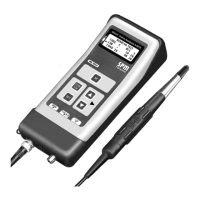60
Technical data are subject to change without notice.
ISO 9001 certified. © Copyright SPM 1996-9. 71411.B
SPM Instrument AB • Box 4 • S-645 21 Strängnäs • Sweden
Tel +46 152 22500 • Fax +46 152 15075 • info@spminstrument.se • www.spminstrument.se
Class Class Class Class
Limits
Preparations for Systematic Monitoring
Preparations:
1 Select suitable machines
2 Define the vibration class of each machine
3 Select one or more measuring points
4 Mark and prepare the measuring point(s)
5 Prepare a follow-up form for each machine
The general preparations for systematic vibration moni-
toring are listed in figure 5.
Suitable Machines
Periodic vibration monitoring with the A2010 is suit-
able for any machine unit which is not subject to
sudden, dangerous increases of the vibration level.
A continuous vibration monitoring system should be
installed on fans where the shedding of a dirt layer or
a breaking blade can lead to sudden out-of-balance.
Vibration Classes
There are three ways to determine the vibration class
of a machine:
1 Use the manufactures' specification of
acceptable vibration levels for their equipment as
a reference. Compare them with the ISO limit
values in figure 6 and select the suitable class.
2 Measure the vibration level when it is reasonably
sure that a machine is in good condition. Choose
a class where that reading falls into the upper half
of the ISO ”good condition” zone, or the lower
half of the ”acceptable condition” zone.
3 Classify the machines according to the ISO
definitions quoted on page 64.
Classification of machinery is largely a matter of expe-
rience because the definitions provided by the stand-
ards are deliberately loose. Most industrial plant be-
longs to vibration classes II, III and IV:
II Medium size machines without special
foundations
III Large machines on rigid foundations
IV Large machines on soft foundations.
For example, most smaller process pumps on a chemi-
cal plant would be Class II. A 100 kW ventilation fan
on a concrete base would be Class III. However, the
same fan fastened to the less rigid metal deck of a
ship could be considered as Class IV.
Fig. 5
Fig. 6
Class I refers to independent parts of machines, for
example electric motors up to 15 kW.
Classes V and VI are used for heavy reciprocating
prime movers and machines which are intended to
vibrate – for example vibrating screens.

